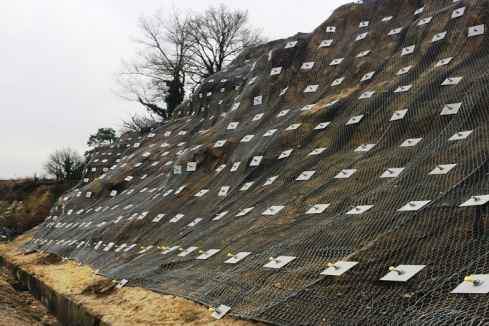Soil Nailing is a method used to strengthen the soil and make it more durable.
Is utilized to make slopes, excavations, retaining walls, and other structures more permanent.
In this article you’ll learn:
- Purpose of Soil nailing.
- Properties of Soil nailing.
- Merits and Demerits of Soil nailing.
- Lots more.
So, if you’re ready to go with it, this article is for you.
Let’s get started!
What is Soil Nailing?
Soil nailing is a method of ground stabilization that may be applied on both natural and excavated slopes.
Drilling holes on a sloping surface to inserting iron bars, which are then grouted in place, is required. The mesh is connected to the bar ends to hold the slope face in position.
Purpose of Soil Nailing:
- It is widely employed as a corrective measure to strengthen embankments, levees, and other structures. Other uses includes:
- Shoring for temporary excavation.
- Tunnel entrances.
- Roadway severance.
- Abutments of a bridge.
- Existing retaining structures must be repaired and rebuilt.
- It is ideal that the soil is ready to stand without reinforcements to a height of 1-2 m for at least 2 days when cut vertically or almost vertically.

Soil Nailing Process:
Soil is strengthened using slender elements such as reinforcing bars known as nails.
These reinforcing bars are placed and grouted into pre-drilled holes.
These nails are also installed at an inclination of 10 to 20 degrees from vertical.
As the digging advances, shotcrete, concrete, or other bridging materials are applied to the dig face to grout the reinforcing steel or nails.
Types of Soil Nailing:
1. Drilled and grouted Soil Nailing method:
The holes in this nailing method are drilled in walls or sloping faces.
After that, nails are inserted into the pre-drilled cavities.
After that, the opening is filled using grouting materials such as concrete, shotcrete, etc. Ultimately, the nail diameter ranges from 100 to 200mm, with a 1.5m spacing.
2. Driven soil nailing method:
It is used to temporarily stabilize soil slopes.
The driven dirt nailing method is quite rapid.
But it does not prevent the reinforcing steel or nails from corrosion.
The nails in the driven method are driven into the slope face during digging.
The nail’s diameter ranges from 19mm to 25mm, which is considered tiny.
Finally, the nail spacing is 1m to 1.2m.
3. Self-drilling Soil Nailing method:
In the self-driven method, hollowed bars are employed.
Strips are drilled into the ramp. Simultaneously with the drilling technique, grout is introduced.
It is faster than drilled grouted nailing.
At last, the self-drilling method is less vulnerable to rust than driven nails.
4. Jet Grouted Soil Nailing method:
In the jet-grouted technique, jets are used to disintegrate the soil and produce pores on the slope surface.
Following that, steel bars are inserted in this hole, and concrete is grouted.
Finally, jet-grouted method protects the steel bars from corrosion (nails).
5. Launched Soil Nail method.
The steel bars are driven into the soil with a single photograph using a compressed air mechanism in this technique.
Soil nails are simple to install, but regulating the length of the bar entering the ground is difficult.
Used to strengthen a shaky or possibly shaky soil mass.
Finally, the nail diameter is 38mm and the length is approximately 6m.
Advantages of Soil Nailing:
- This nailing is effective in tight spaces with restricted access.
- It is less of an influence on the environment.
- They are quite quick and simple to set up.
- It employs fewer materials and shoring.
- They are adaptable enough to be employed on new buildings, temporary structures, and remodelling projects.
- There are no height restrictions.
Disadvantages of Soil Nailing:
- They are not good for high-water-table locations.
- Extremely increased soil nail density may be required in low shear strength soils.
- They are not appropriate for long-term usage in delicate and expanding soils.
- Specialized contractors are needed.
- It is possible that extensive 3D modelling will be necessary.
Applications of Soil Nailing:
- Conventional retaining wall stabilization.
- Digging retaining structures for high-rise buildings and subterranean infrastructure in metropolitan locations.
- Salvation by a landslide.
- Highway and roadway embankments, as well as cut slopes, must be stabilized.
- Tunnel entrances on unstable, steep stratified slopes.
- Bridge foundation construction and rehabilitation.
- Stabilizations for steep cutting.
- Stabilization of existing very steep embankments.
- It give concrete floor buildings long-term stability without the need for destruction or reconstruction.
Also read: Concrete Spalling | Quarrying of Stone | Soil Liquefaction
Conclusion:
This method demonstrated that, regardless of slope angle or soil composition, the internal friction angle is the most vulnerable soil parameter in terms of the global safety factor.
Cohesion is more essential than soil unit weight, although both are far less sensitive than the internal friction angle.
These conclusions agree with previous sensitivity testing on natural slopes.
An extensive sensitivity analysis might consider all of the various circular slip surfaces in a soil nailing design.

Related Posts
Rock Quality Designation(RQD): Building Strong Foundations
Spread Footing
Masonry Cement
Plain Cement Concrete
Concrete Efflorescence
Concrete Pile
Stepped Footing
Fineness Modulus of Coarse Aggregates
Difference between Condo and Apartment